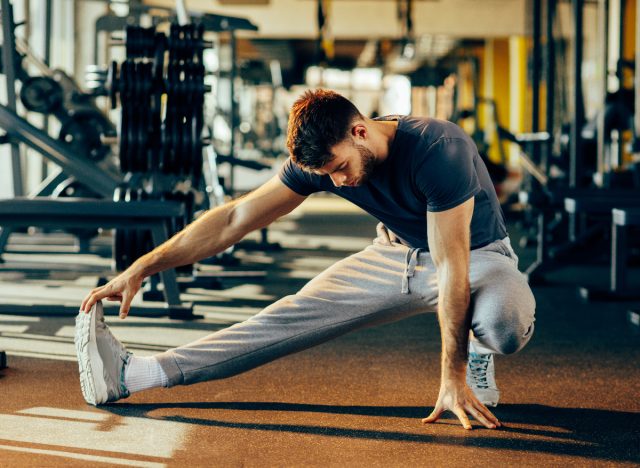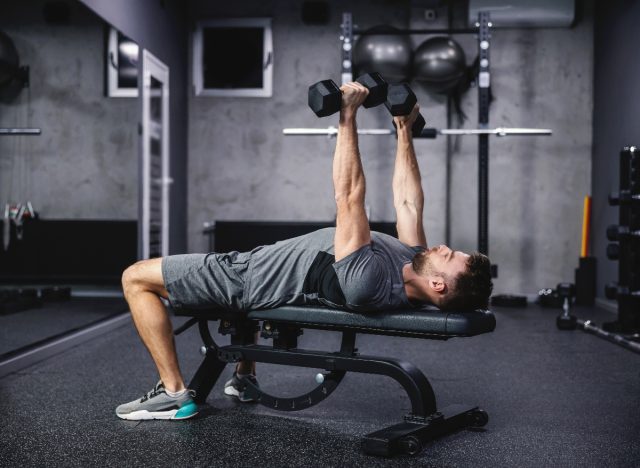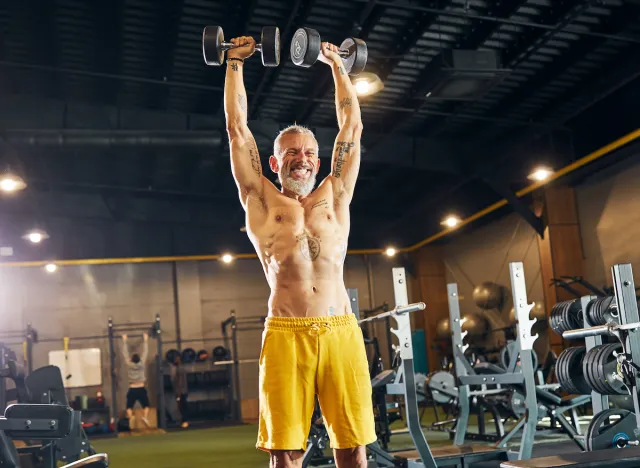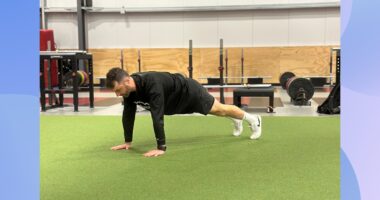It’s always a shame when I see motivated, dedicated men hitting the gym and yet not making progress due to simple mistakes. If you currently work out or are planning to start, you can drastically improve your strength and muscle growth results with some general resistance training guidelines. It’s not worth wasting time, energy, and money on a routine while making basic mistakes. The following are my top seven mistakes men make at the gym that kill progress. Avoid these mistakes, and maximize your gains in your workouts.
Keep reading to learn about the bad habits to avoid on your next gym day, and then, don’t miss 5 Exercise Habits That Are Destroying Your Body After 50.


Given how rushed many of us are for time, it’s tempting to skip warmups and want to get “in and out” when it comes to working out. Although I sympathize with a busy schedule, I can tell you that shaving 10 minutes off your workout to skip warmups is hurting your progress long-term.
While there is no perfect warm-up, performing three to five minutes of light aerobic activity, then going through some core activation exercises such as bird dogs and side planks, followed by dynamic movements like walking lunges is a great way to get your body loosened up and ready for exercise.
Research suggests that this can help reduce injury risk. A single injury can set back weeks or even months of progress, so preventing injuries ahead of time is key.


If your entire gym routine revolves around machines, you are doing it wrong. While there is a place for machine-based exercises in fitness programs, healthy individuals should focus most of their time and effort on compound movements with dumbbells and barbells.
Movements with dumbbells and barbells require greater stabilization, recruit more overall muscles, and have better transfer to functional activities. Don’t be afraid to do a few machine exercises in your workout, however, most of your work should focus on free weights.


I am the last person to completely ban a certain type of exercise or workout. However, for most male fitness goals involving strength and muscle growth, high-repetition sets are not the best route to results. If you are performing more than 15 to 20 repetitions on a single set of your main workout, you are not using enough weight to drive the deep adaptations in the muscle fibers that result in bigger, stronger muscles.
Focus on sets where failure occurs between five and 12 repetitions. The closer to 12, the more emphasis you put on muscle growth. The closer to five (or even one), the more emphasis on maximal muscular strength.


Bicep curls and triceps extensions have a place in your workout. However, just like using weight machines, focusing on isolation exercises uses fewer muscles in a less functional pattern. You should try to include no more than two or three isolation exercises in a workout and put them after your compound exercises such as squats, pullups, deadlifts, and bench pressing to maximize your overall results.
READ RELATED: Is Hereditary Baldness Preventable? Unraveling the Genetic Code


Cardio is good for all of us, right? Well, yes and no. Doing aerobic exercise is certainly beneficial for your health. Furthermore, if you are training for an endurance event, you will necessarily be focusing on longer endurance-focused training instead of heavy lifting.
However, if your goal is muscle growth and strength gains, you do not want to put too much emphasis on cardio. Your body needs to adapt to the resistance training stimulus separate from the aerobic training stimulus. If you are constantly blasting your body with endurance training, you will not have the chance to build new fibers and recover from your strength workouts.
Keep cardio to between 20 and 30 minutes, no more than twice per week on your rest days as an active recovery.


I get it—stretching sucks. But not stretching is one of the worst mistakes men make at the gym that crush their progress.
While you do not have to stretch to see muscle and strength gains, there are some benefits to flexibility training that you will miss out on. Flexibility training includes foam rolling, passive stretching, and active stretching.
I am not saying you need to be a yoga master. However, including a 10-minute full-body stretching session after each workout or on rest days can reduce some soreness and keep your muscles at optimal lengths. Plus, being stiff and sore all the time is no fun, so I will always recommend anything that can help tone that down a bit.


The perfect workout program you never do is worthless for your gains. Regardless of what program you follow, consistency is king. If you don’t have the time, energy, or inclination to follow a “perfect” workout plan, don’t let that stop you.
Consistency over time is the only way to see real results. Rome wasn’t built in a day, and neither are big, strong muscles. Expect a minimum of three months from whatever program you follow before the results start kicking in. However, you essentially need to continually maintain your fitness throughout your entire life, so find a workout routine that is realistic for the long haul.
Source:











